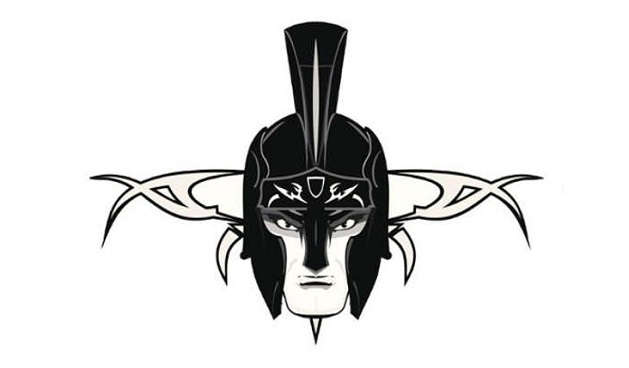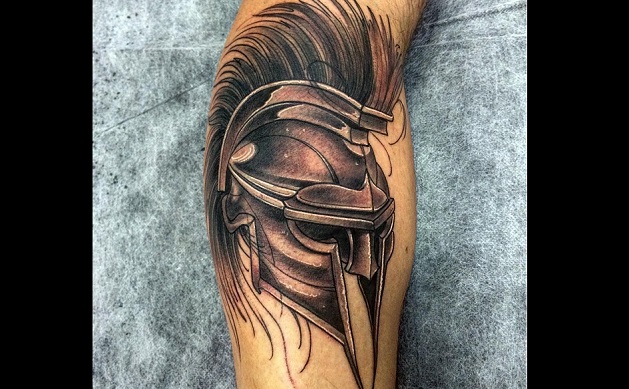In the world-famous and often cited grave inscription the memory of the Spartan king Leonidas and his three hundred elite soldiers, the 480 v. Chr. Heroically defended the pass in the legendary Battle of Thermopylae, kept awake.
In addition to the immediate military and political consequences of this event unfolded its world-historical significance in the (subsequent) victory of the Greek world against the onrushing Persian hordes made possible by this sacrifice and the thus enabled rescue of the West.
Spartans – Meaning and Symbolism
American filmmaker, writer and filmmaker Frank Miller’s “300”, which created a sensation in 2007, opened up an extraordinary view of this historic world, with its ideals of honor, responsibility to its own people, and the bravery of our decadent, hedonistic, and tradition-negating ones Present diametrically opposed. Likewise inspired by the Sparta model is the movement of identities that is currently under construction, leading across Europe the “Lambda” crest, a symbol of shared tradition and history, proudly carried by the Spartan warriors on their shields.
From a historical point of view, while many traditional opinions on Spartan values such as valor, discipline, loyalty and order do not constitute generalizable legends about the Spartan state, “the Spartan par excellence,” Leonidas, the brilliant defender of Thermopylae, offers pure embodiment of Spartan essence par excellence”, an opportunity to recall the need for heroic myths and the willingness to act in times of need. The will to act here found a world-historical expression and manifests a cornerstone of occidental identity.
As in 480 BC The Persian land forces, accompanied by the following fleet, crossed the Hellespont on two bridges, many Greek (city) states helplessly delivered to the fearsome army of King Xerxes and commemorated the recognition of Persian rule. In this situation, Sparta and Athens, of world historical significance that would have meant a defeat for the occidental cultural space, seized the initiative to fight together against the cautiously estimated 100,000-strong army of Xerxes. For power-political reasons, but also out of responsibility for the Hellenic world, Sparta willingly took the leading role in this “newly formed Greek military community, which summed up all anti-Persian forces in Hellas” (Weber, p. 267). Strategically, the Greeks planned to decimate the Persian fleet to morally destabilize the enemy land forces, and it was crucial to deny the Persian troop’s access to Greek territory until the fleet was defeated by Xerxes.
The most tactically favorable terrain for defensive position was Sparta’s defensive support in the Thermopile Pass, the narrow ravine between the sea and the Oita Mountains, where the 7,000-man army of King Leonidas was to defend this single access to central Greece. This position unfolded its tactical-strategic advantage through the narrowness of the pass, whereby the mighty army of the Persian ruler could only attack with a few soldiers.
At the same time, the approximately 200 ships of the Greek fleet cruised near the thermopile position in order to block the sea route and ultimately force the decision with the Persian fleet. The parallel advance of Xerxes’ sea and land forces led to the almost simultaneous encounter with the Greek fleet and the army of Leonidas.
Xerxes’ conviction that he was able to gain Thermophile status quickly led him to first send the median troops into the fight against the Spartans, but they failed, as did the Persian elite unit of the “immortals” thrown into action on the following day Homeland defender under Leonidas’ leadership. The Spartan tactics enabled these brilliant victories, but could not catch the betrayal of the Greek Epilates, who called the Persians a bypass path around the Thermopile Pass: although Leonidas, knowing the explosive situation, left a thousand heavily armed warriors to guard this detour, they were able to do so Persian army unstoppable, so that Xerxes was in central Greece and the consequently meaningless position could be attacked at the Thermopile from behind. Leonidas, by messengers about this development The Confederates dismissed their duty and, despite the possibility of a safe withdrawal with his three hundred-man elite unit and a thousand periods and seven hundred thespians, remained in the fateful and deadly position, for Spartan’s warriors “would not be able to leave the field, to which they came from the beginning to guard him “(Herodotus).
Committed to the Spartan warrior ethic and its values of bravery, loyalty and discipline, these fierce converts of Hellas defied the onrushing Persian hordes long and steadfastly. The course of this struggle portrays Herodotus in rhetorical pathos, which should not be left unmentioned here: “The barbarians around Xerxes arrived, and the Greeks around Leonidas, now that they were about to march to certain death, moved even more as at the beginning to the wider part of the bottleneck. As they collided outside of the confines, a great many barbarians fell, as from the back the leaders of the detachments kept forcing all men with flagella on and on. Many of them plunged into the sea and died, but many more soldiers stepped down alive.
No attention was paid to the perished. Since the Greeks knew that death would be imminent by those who had bypassed the mountains, they showed the highest degree of power with regard to the barbarians, without contempt for death and contemplation. Most of them had already broken the spears that day, but they beset the Persians with their swords. In this fight fell Leonidas, an outstanding hero, as well as many other well-known Spartan with him. The fight lasted until the people arrived under the guidance of the Epilates. When the Greeks heard of their arrival, the battle took a completely different course.
For one thing, they retreated to the narrowness of the road, and then, after marching past the wall, they came to rest on a hill. Here they defended themselves with swords, if they possessed one more, and with their hands and teeth, but the barbarians showered them with their projectiles, the ones that had attacked them from the front, and had torn down the defenses of the wall, and the others, who came from all sides and surrounded them ” Herodotus. The military consequences of the Battle of Threnody Herodotus’s myth-making approach are closely related to the real-historical events, which completely destroyed the few remaining defenders of Thermopylae.

Nevertheless, the brave resistance of the Spartans caused the rest of the Greek forces to regain their strength and, after the pillage, to strike back parts of the Hellenic world by the Persians: the famous and victorious naval battle of Salamis was the result of the joint effort of the then spearhead of the Spartans occidental world – of the Greeks! When the old historian Erich Bayer wrote in 1966, “The sacrifice of the 300 Spartans had not only a deep moral impact, but also its current strategic importance,” he recalled the time corridor won by the warriors for Leonidas, which gave it to much of the Greek allies , who had to retreat after a battle of several days with the Persian fleet at Cape Artemisia, allowed to “escape through the narrow strait between island and mainland, because just at the same time on the Thermopylae Leonidas with the rest of the Greek squad further advance.
Although Central Greece was lost and Athens in the hands of the Persians at that moment, the Greek fighters were able to “gather on the last and most effective defensive line, the Isthmus” (Erich Bayer op. Cit.) And led by the Athenian Themistocles into the decisive battle of Salamis pull. “A more favorable balance of power than in August at Artemisia (about 400: 300 ships), the familiar, narrow waters, the courage of despair, which increased to sacred enthusiasm – all this worked together, that Xerxes, from a hill of the Attic country from the battle panorama, on that September day of the year 480, the defeat of his fleet and the loss of an elite unit of his nobility had to watch. Discouraged, he returned home the way he had come; he left behind a ruined Athens, but also a land army, which remained under Mardonius in Thessaly”.
Spartan Tattoo – Designs and Ideas
Tattoos are now so popular that they are quite often placed in prominent places. For example, wrists, fingers, collarbones and necks are also particularly popular with lettering or other tattoo motifs. So that you can get an idea of where the best spot for a tattoo could be for you, we have created a small guide for you. Spartan tattoos are especially popular among people because they carry a strong symbolic and historic symbolism in them. Spartan tattoos come in various shapes and sizes and you should wisely pick a place where to do the tattoo.
If you decide to have a tattoo on your back, be sure that you may never get enough of it. Also, in the event that tattoos in society are again disapproved, the back is a good place to get tattooed. The neck, which is now also a particularly hot spot, makes it more difficult. If you are one of those ladies who opt for a “practical” short hairstyle in their late fifties, you may run the risk of being asked about the meaning of the tattoo on your neck.
The tattoo can look pretty good if you decide on the shoulder. In summer, this spot is also prominent and worse to cover up, that should be your intension. The hands and fingers have increasingly moved into the tattoo focus. Here you should be quite sure what you do and have a really good tattoo artist at hand. Tattoos on the hands can quickly appear out of focus and run when they are too deeply stung. Dear first tattoo carefully and then let again piercing.
Also the feet are in high demand. But here, too, there is one or the other problem: If not deep enough was stung and the tattoo, for example, on the crack, then this can actually run the risk of fading. On the outside of the foot you have to fight again with the cornea, here it is very clean and sting evenly.
When deciding on the tattoo you want to get, make sure you discuss the design about the tattoo you want to get. Spartan tattoos look great when they are larger and placed on back or forearms. You can also opt for a Spartan helmet or shield, which in that case can be smaller in size. Spartan warriors are the most popular motifs and you can tattoo them in various positions. You can opt for the battle position or for a standing position.
They are already a strong symbol of power and masculine energy, which makes them a powerful symbol enough without adding any other kind of symbols besides them. Make sure you choose the right position for your tattoo before you do it, because this is something that stays on your body for a long time.

